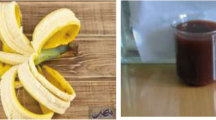Abstract
Purpose
This study aims to explore the effects of antimony (Sb) on the nutrient composition of green leafy vegetables.
Materials and methods
Red beets (Beta vulgaris L.), mallow (Malva sinensis Cavan.), and Chinese cabbage (Brassicacampestris L.) were planted by pouring antimony solution in flowerpot, then the protein content of plants and the changes of seven nutrient elements such as Ca, Mg, Fe, Mn, Zn, Cu, and I under Sb stress were studied.
Results and discussion
The results showed that the red beet had the highest protein content when the concentration was 20 mg L−1, which was 0.2856 gprot L−1. With an increase in the antimony concentration, the protein content decreased gradually, and the protein content of mallow and Chinese cabbage did not change significantly. For nutrient elements, except for Ca and I, other nutrients in red beets increased with the increase in antimony concentration, and Mn and Zn contents in mallow were reduced to the lowest when Sb was treated with 100 mg L−1, while content of I element was the highest at 100 mg·L−1, and the content of nutrients in Chinese cabbage changed in a small range.
Conclusions
The research showed that the antimony pollution had a great influence on the protein content of red beet. The nutrient content of mallow was fluctuated greatly when Sb was treated with 100 mg L−1. The content of Mn, Zn, and Cu in Chinese cabbage almost did not change due to the antimony concentration.








Similar content being viewed by others
References
Baroni F, Boscagli A, Protano G, Riccobono F (2000) Antimony accumulation in Achillea ageratum, Plantagolanceolata and Silene vulgaris growing in an old Sb-mining area. Environ Pollut 109:347–352
Benavides MP, Gallego SM, Tomaro ML (2005) Cadmium toxicity in plants. Braz J Plant Physiol 17:21–34
Corrales I, Barceló J, Bech J et al (2014) Antimony accumulation and toxicity tolerance mechanisms in Trifolium species. J Geochem Explor 147:167–172
Ding D, Guo YC, Zuo YM (2018) Effects of light and NaCl stress on seed germination of three kinds of malvaceae. Jiangsu Agr Sci 46:163–166
He MC, Ji HB, Zhao CY (2002) Preliminary study on heavy metal pollution in soil and plants in antimony mine area. J Beijing Normal U (Nat Sci) 38:417–420
Li W (2010) Effect of Cd on nutrient elements and free amino acids of Kandelia candel seedling. Dissertation, Sun Yat-Sen University
Liao W, Zhao YL (2008) Effects of earthworm stress on seed germination and seedling growth of four vegetables. Hunan Agr Sci 04:86–88
Ma NL, Li M, Wang YY (2018) Counter measures for sudden antimony pollution in Taipu River. Water Conser Sci Technol Eco 24:19–22+30
McCallum RI (2005) Occupational exposure to antimony compounds. J Environ Monit 7:1245
Shtangeeva I, Bali R, Hams A (2011) Bioavailability and toxicity of antimony. Geochem Explor 110:40–45
Song SQ, Wu HD, Lan WY (2008) Preliminary study of antimony on growth of mulberry-tree. Resour Dev Market 1:1–3+88
Wang XX, Huang XH, Hu FJ (2018) Characteristics of Pb, Zn accumulation and foliar nutrient in four kinds of woody species. J Central South Univ Forestry Technol 38:115–122
Wang YZ, Hu N, Liu QZ (1999) Study on the vitamin content in different flesh color varieties of apricot. J Fruit Sci 16:51–54
Xiong LM, Schumaker KS, Zhu JK (2002) Cell signaling during cold, drought, and salt stress. Plant Cell 14:165–183
Xu QQ, Tang SZ, Wang HY (2019) Simultaneous determination of 27 trace elements in manure by HNO3-HClO4 digestion-inductively coupled plasma mass spectrometry method. Model Chem 39:235–238
Yang ZK, Wang XL, Long SH (2012) Determination of protein in soybean stems and leaves by Bradford method. Hubei Agr Sci 51:4610–4612
Yin ZY, He JQ, Liu DH (2018) Advances in research on soil mites pollution characteristics and application prospects of enriched plants in China. J Agr Resour Environ 35:199–207
Zhang JR, Zhou YZ, Ye M (2017) Bioavailability of heavy metal and transfer factors in a regional soil-to-crops system. Environ Sci Technol 40:256–266
Zhang R (2016) Analysis of compositions and heavy metals of four wild vegetables in Nanjing suburb. Dissertation, Nanjing Agricultural University
Zhang ZL (1990) Plant physiology experiment guide, 2nd edn. Beijing, China, pp 154–155
Author information
Authors and Affiliations
Corresponding author
Additional information
Responsible editor: Claudio Bini
Publisher’s note
Springer Nature remains neutral with regard to jurisdictional claims in published maps and institutional affiliations.
Rights and permissions
About this article
Cite this article
Geng, L., Yang, Z. & Xu, Z. Effects of antimony contamination in soil on the nutrient composition of three green leafy vegetables. J Soils Sediments 20, 2217–2224 (2020). https://doi.org/10.1007/s11368-020-02577-4
Received:
Accepted:
Published:
Issue Date:
DOI: https://doi.org/10.1007/s11368-020-02577-4




